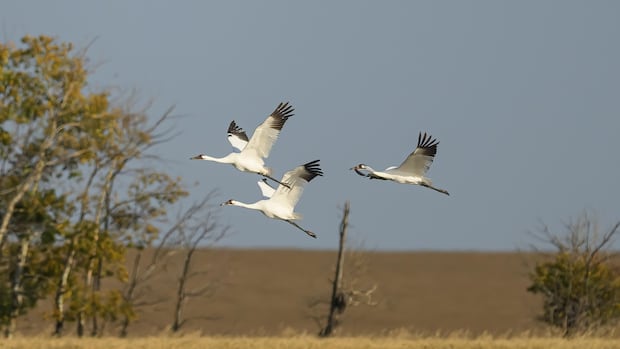SaskatchewanConservationists say Saskatchewan is the best place in the world to spot the endangered whooping crane during its winter migration from northern Canada to the Texas coast.Group runs birding tours to help count migrating flocks of the endangered birdJeremy Warren · CBC News · Posted: Sep 22, 2025 6:59 PM EDT | Last Updated: 2 hours agoWhooping cranes fly over Saskatchewan farmland in this undated fall photo. (Submitted by Boyd Coburn)Saskatchewan is one of the best places in the world to catch a rare glimpse of whooping cranes during migration and right now is the prime time to watch them head south for the winter, says writer and naturalist Trevor Herriot.Prairie wetlands are a favourite stop for whooping cranes migrating between breeding grounds in Wood Buffalo National Park and their winter home on the coast of Texas. Their breeding range used to include Saskatchewan, until hunting and habitat loss nearly wiped the species out 100 years ago.Now they just stop here to rest.”I think we need to find a place in Saskatchewan where they could be breeding here again,” Herriot said during an interview on CBC’s Blue Sky. “This was the core of their former breeding range, and it would be wonderful someday.”Migration started several weeks ago and will continue into late October.Whooping cranes — not to be confused with the more common sandhill crane — almost went extinct in the early 20th century. Decades of conservation efforts turned that around, growing the Canadian population to around 550 from a low of just 14.”When we want to and we put in the effort, we can recover a species from the brink of extinction,” Herriot said. “You just have to spend the resources, energy and time and goodwill to do it.”Veteran birder Stan Shadick has run whooping crane tours for years, helping count the flocks heading south every year. All proceeds from the tours go to Living Sky Wildlife Rehabilitation in Saskatoon.The first tour group counted 16 whooping cranes on Sept. 5, and the total so far this winter migration season is 72, Shadick said in an interview with Blue Sky.”I think a lot of people have forgotten that the ancient homeland for whooping cranes is right here in southern Saskatchewan,” Shadick said. “They are really a Prairie nesting bird. They belong on the Prairies.”At one point in the early 1900s, the whooping crane’s numbers dwindled to fewer than 40 birds, making its conservation critically important. (Gary Leavens CC BY-SA 2.0/Wikimedia Commons)The last known whooping crane nest in the province was recorded in 1929 at Luck Lake in south-central Saskatchewan. Whooping cranes are the tallest bird in North America at 1.5 metres and have a lifespan of 22 to years, according to Nature Canada.”Because of the long lifespan, they have this very low rate of reproduction and they also don’t nest until they’re about five years old,” Shadick said.Some people report seeing whoopers when they actually saw a flock of sandhill cranes, but it’s not uncommon to see a couple of white whoopers mixed in with brownish sandhill cranes. Whooping cranes are taller than their more common crane cousins.”You hardly need binoculars because they are so big,” Herriot said.”They tend to be in more open landscapes, wetlands or landscapes very close to wetland crops.… They are just such spectacular and graceful birds.”ABOUT THE AUTHORJeremy Warren is a reporter in Saskatoon. You can reach him at jeremy.warren@cbc.ca.With files from Blue Sky
Whooping crane winter migration is prime time for birders in Sask.











